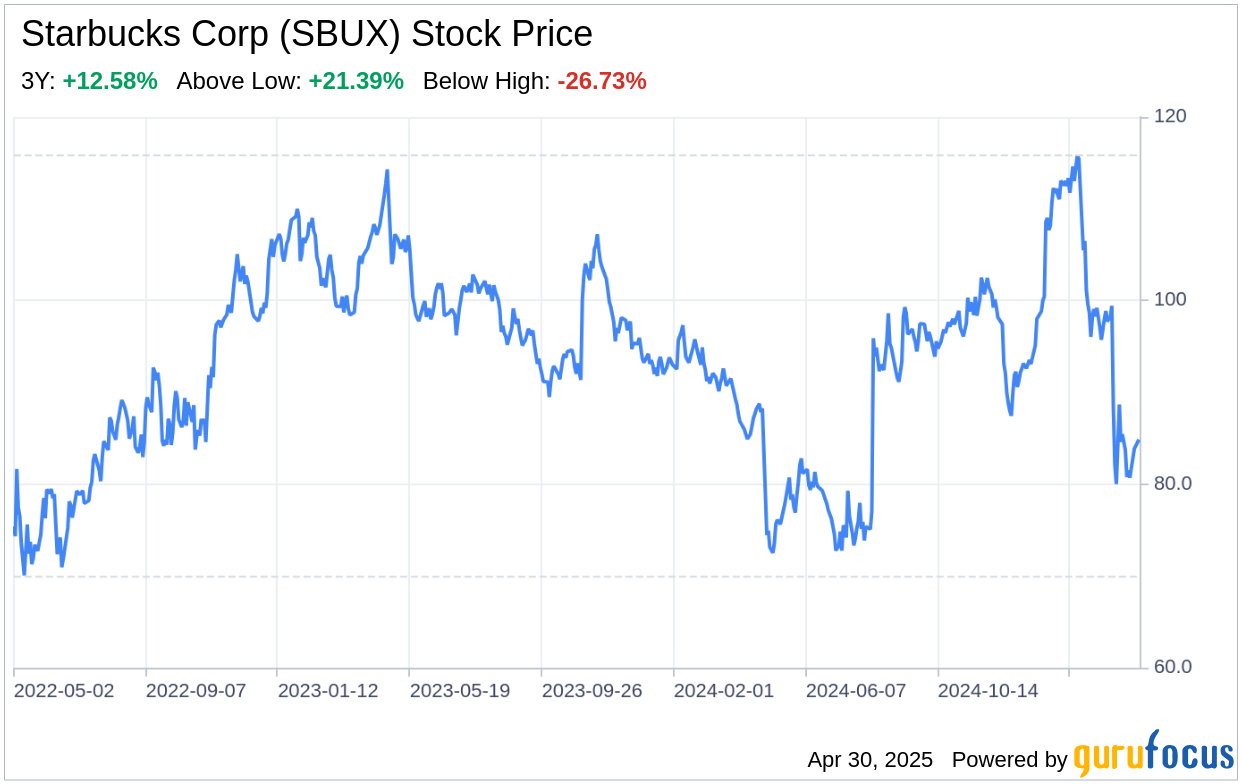On April 29, 2025, Starbucks Corp (SBUX, Financial) filed its 10-Q report, revealing the company's financial performance and strategic positioning. As a leading global coffeehouse chain, Starbucks operates over 40,000 stores worldwide, with a diversified revenue stream from company-operated stores, royalties, and sales of products to license partners, among other channels. The latest filing indicates a 2% increase in consolidated net revenues to $8.8 billion, despite a slight decline in global comparable store sales and a challenging macroeconomic environment. Operating margin contracted to 6.9%, reflecting investments in growth strategies and restructuring costs. With a strong brand and strategic initiatives, Starbucks is poised to navigate market uncertainties and drive long-term growth.

The following SWOT analysis delves into the strengths, weaknesses, opportunities, and threats as discerned from Starbucks Corp's recent SEC 10-Q filing, providing investors with a comprehensive understanding of the company's current position and future prospects.
Strengths
Brand Power and Customer Loyalty: Starbucks Corp's brand is synonymous with premium coffee and a unique customer experience. The company's ability to maintain a loyal customer base is evident in its sustained revenue growth, with a 2% increase in consolidated net revenues to $8.8 billion in the latest quarter. This strength is bolstered by the company's strategic marketing and innovation, which continue to attract and retain customers globally.
Global Footprint and Diversified Revenue Streams: With over 40,000 stores in more than 80 countries, Starbucks has a significant global presence. The company's diversified revenue model, which includes company-operated stores, royalties, and sales of packaged and single-serve products, provides multiple channels for income generation, contributing to its financial resilience.
Operational Efficiency and Strategic Initiatives: Starbucks' operational efficiency is reflected in its ability to open new stores and maintain the attractiveness of existing ones. The company's "Back to Starbucks" strategy and restructuring efforts aim to streamline operations and enhance efficiency, as evidenced by the opening of 1,283 net new company-operated stores over the past 12 months.
Weaknesses
Market Sensitivity and Economic Conditions: Starbucks' performance is susceptible to global economic conditions, including consumer spending behavior and discretionary income levels. The recent contraction in operating margin to 6.9% highlights the impact of such external factors on the company's profitability.
Commodity Price Risks: As a major purchaser of green coffee and dairy products, Starbucks faces commodity price risks that can affect its cost structure and margins. The company's financial results are influenced by fluctuations in these commodity prices, necessitating effective risk management strategies.
Restructuring Costs: The company's restructuring initiatives, part of its "Back to Starbucks" strategy, have resulted in significant costs, with pre-tax restructuring charges of $116.2 million in the latest quarter. While these efforts are aimed at long-term efficiency, they currently weigh on Starbucks' financial performance.
Opportunities
International Expansion and Market Penetration: Starbucks continues to see opportunities for growth in international markets, with a 5% increase in company-operated and licensed stores. The company's expansion into emerging markets and further penetration in existing ones offer potential for increased revenue and market share.
Innovation and Product Diversification: Starbucks' focus on innovation, including the development of new products and enhancements to the customer experience, presents opportunities to attract new customers and increase sales. The company's diversified product offerings, such as ready-to-drink beverages and packaged coffee, allow for expansion into different consumer segments.
Strategic Partnerships and Alliances: Collaborations, such as the Global Coffee Alliance with Nestlé, provide Starbucks with additional channels for growth. These partnerships enable the company to leverage its brand and reach new customers through alternative distribution networks.
Threats
Competitive Market and Pricing Pressures: Starbucks operates in a highly competitive market, facing pressure from both established players and new entrants. The company must continuously innovate and adapt to maintain its market position and manage pricing pressures that can affect profitability.
Regulatory and Geopolitical Risks: Changes in regulatory environments, trade policies, and geopolitical tensions can impact Starbucks' operations and supply chain. The company must navigate these complexities to ensure business continuity and compliance with local and international laws.
Consumer Preferences and Health Trends: Shifts in consumer preferences, particularly related to health and wellness trends, pose a threat to Starbucks' product offerings. The company must remain attuned to these changes and adjust its menu to align with consumer demands.
In conclusion, Starbucks Corp (SBUX, Financial) demonstrates significant strengths in brand equity, global presence, and strategic initiatives that position it well for future growth. However, the company must address weaknesses such as sensitivity to economic conditions and manage risks associated with commodity prices and restructuring costs. Opportunities for international expansion, product innovation, and strategic partnerships are promising, but Starbucks must also be vigilant of threats from competition, regulatory changes, and evolving consumer preferences. Overall, Starbucks' SWOT analysis reveals a company with the potential to leverage its strengths and opportunities to overcome challenges and continue its trajectory of success.
This article, generated by GuruFocus, is designed to provide general insights and is not tailored financial advice. Our commentary is rooted in historical data and analyst projections, utilizing an impartial methodology, and is not intended to serve as specific investment guidance. It does not formulate a recommendation to purchase or divest any stock and does not consider individual investment objectives or financial circumstances. Our objective is to deliver long-term, fundamental data-driven analysis. Be aware that our analysis might not incorporate the most recent, price-sensitive company announcements or qualitative information. GuruFocus holds no position in the stocks mentioned herein.
